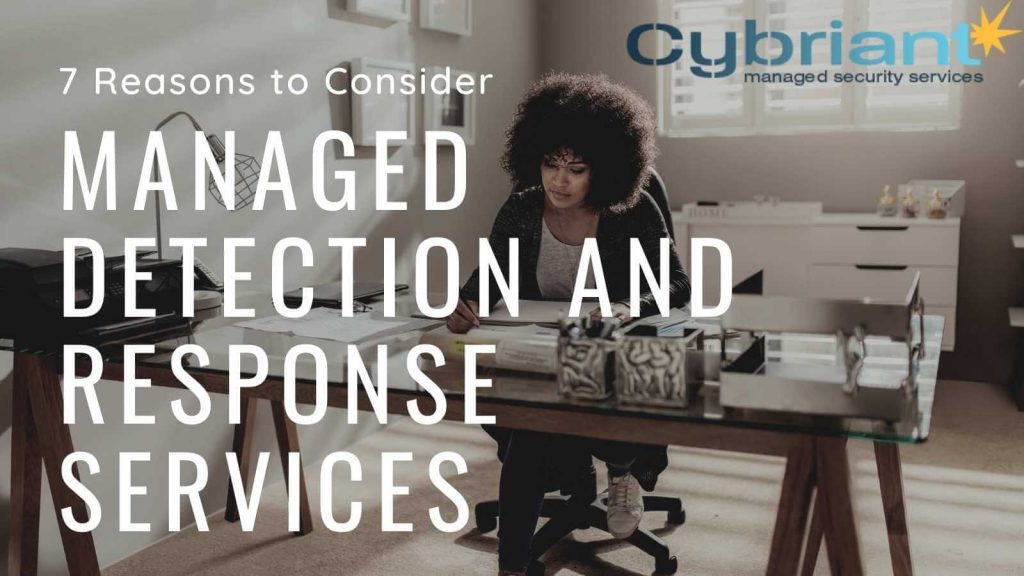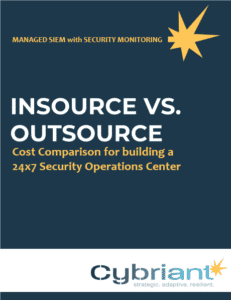Managed Detection and Response services have become vital in this ‘work from home’ age. For many employees, working from home has boosted productivity and employee morale. It has also boosted security concerns for many IT departments.
Since many organizations may have to deal with a remote workforce for an undetermined amount of time, it’s important to consider Managed Detection and Response services to protect your organization’s data.
What is Managed Detection and Response?
MDR is an outsourced managed security service that provides advanced protection on endpoints. MDR provides more advanced and deeper detection plus the ability to stop malware in its tracks. Typically, MDR uses AI and machine learning for deeper security analysis.
According to Gartner, Managed detection and response (MDR) providers deliver 24/7 threat monitoring, detection, and lightweight response services to customers leveraging a combination of technologies deployed at the host and network layers, advanced analytics, threat intelligence, and human expertise in incident investigation and response. MDR providers undertake incident validation, and can offer remote response services, such as threat containment, and support in bringing a customer’s environment back to some form of “known good.”
MDR service providers, like Cybriant, typically focus on threat detection and analytics. Automation is used in our MDR technology, but experienced experts are required to watch that technology on a 24/7 basis. Plus, MDR from Cybriant is all about Remediation…not just Response.
What is MDR Technology?
Our security platform uses artificial intelligence to track and contextualize every single activity on your computer systems. The Cybriant security platform will pinpoint malicious acts in real time and automatically stop them in their tracks before they become a threat.
When your team works remotely, you’re open to new threats, from the smart TV to the connected printer, and everything in between. Protect your workforce from every avenue of attack with Cybriant MDR.
Malware doesn’t need a connection to attack, and neither should your cybersecurity. Cybriant delivers Online/Offline Protection across any platform or OS—because if your security only works online, it doesn’t work.
Plus, with Cybriant’s team of security analysts watching your network 24/7, you’ll always be protected.
7 Reasons to Consider Managed Detection and Response Services
#1. Establish WFH (Work from Home) Best Practices
It’s reasonable to assume that around 30% of the population remains working from home.
So it makes sense to adopt the best remote working technology practices now so that when things do return to normal, your business is set to reap these benefits and have accelerated growth.
The right system tools and hardware play a big part in enabling a happy and productive remote workforce.
Even before the COVID-19 pandemic. Then, the majority of companies transitioned to remote work, if temporarily. It’s made the viability of a remote workforce plain.
- Research into the likelihood that different occupations could work remotely going forward found:
- 34% of American jobs could “plausibly be performed from home”;
- Up to 29% of Argentinians and 34% of Uruguayan workers are in occupations doable remotely;
- In Europe, the same holds for 24% of workers in Italy, 28% in France, 29% in Germany, 25% in Spain, and 31% in Sweden and the UK.
When employees work from home, they face unknown threats and new attack surfaces. Managed Detection and Response services will protect most of the endpoints that your employees have access to.
#2. Ransomware Attacks Can Happen To You
Ransomware is a well-named type of cyberattack. Cybercriminals taking this approach to kidnap your data. After accessing your network, they encrypt files and demand payment for the passcode. Here are the top seven things you need to know about this business threat.
Cybercriminals rely on your false confidence. We’ve all been guilty of thinking, “it won’t happen to me.” All organizations, especially small to medium businesses, are targeted. Large enterprise organizations may have the resources they need to protect their networks, but mistakes are common in a DIY environment.
A common method to send out phishing emails in the hope of having people enter their access credentials. Targeted business communication emails work, too. The attacker gets to know your business first. Then they send an email impersonating a colleague, supplier, or customer asking you to take action or update contact details by clicking on the link or downloading a file.
In a recent article, we explained in depth the Top Ransomware Threats of 2020. Managed Detection and Response services are vital to prevent ransomware attacks from executing.
#2 Ransomware Spreads Fast
Ransomware is malware, malicious software that can reach a network. So, if Jane from accounting opens a ransomware file, every single computer on your business network could be infected. The virus can spread between businesses, too. Consider the debilitating WannaCry ransomware attack of 2017. Within four days of its first detection in Europe, the strain had spread to 116 countries.
Be prepared for more ransomware in 2021. Cybersecurity Ventures has predicted that, globally, businesses in 2021 will fall victim to a ransomware attack every 11 seconds, down from every 14 seconds in 2019. That figure is based on historical cybercrime figures. It is estimated that the cost of ransomware to businesses will top $20 billion in 2021 and that global damages related to cybercrime will reach $6 trillion. Yes, that is with a “T”.
#3. You Need 24/7 Coverage But Don’t Have The Resources
The cybersecurity skills shortage is one of the trends we can expect to see in 2021. It’s not easy to staff a security operations center (SOC) with skilled individuals, plus try staffing around the clock. You may have a team that is dedicated to your IT department, but they are also helping to support your business. Running a 24/7 SOC is our only business.
A recent study from (ISC)2 claimed the global security workforce needs to increase by a staggering 145% to cope with a surge in hiring demand. In Europe, this has come particularly in smaller companies with one-99 employees, as well as those with over 500 employees.
Unsurprisingly, over half (51%) of cybersecurity professionals said their organization is at moderate or extreme risk due to staff shortages.
This is the #1 reason to consider outsourcing some or all of your security needs. Here are 9 Unique Reasons to Outsource Cyber Security Monitoring.
#4. You Know You Need Threat Detection, but Do You Need a SIEM
Managed Detection and Response (MDR) and SIEM are different solutions but they are complementary to each other and work well together, especially in a managed solution – we have a service called PREtect that uses both as well as vulnerability management.
A SIEM that is performing at peak performance should outperform MDR in detection. Detection is the key to SIEM. It’s important to have a team that can help respond to any problem that is detected. A SIEM can be deemed pointless if it is only noise and you aren’t able to respond to any potential threats.
An MDR should outperform a SIEM in prevention. MDR is designed for endpoint prevention and analysis. But both MDR and SIEM require staff training, tuning, and maintenance
However, the distinctions between the two blur their common purpose and obscure the importance of a holistic cybersecurity platform in the enterprise network. Cybersecurity solutions perform optimally when they integrate effectively with each other and utilize their different capabilities.
#5. Cyberattacks Are Costly, Prevention Is Not
Once the ransomware is installed on your system, it locks down your files. To regain access to the files, you need the password or decryption key the attacker supplies when you pay up; that’s if they keep their end of the bargain once you pay the ransom. These are crooks you’re dealing with after all!
In Coveware’s analysis of Q3 2019, the average ransom payment increased by 13% to $41,198 as compared to $36,295 in Q2 of 2019. And that’s just the cost of the ransom. Indirect costs include the cost of downtime, lost revenue, and long-term brand damage. There’s also the expense of removing the ransomware, forensic analysis, and rebuilding systems.
The average ransomware attack in Q3 2019 resulted in 12.1 days of downtime. — Cover
Ransomware is a lucrative, relatively easy mode of attack for cybercriminals. They could target your business. Prevention in the form of Managed Detection and Response services is significantly less than the cost of dealing with a ransomware attack.
#6. You Can See What AntiVirus Has Missed
Many organizations are not comfortable removing their antivirus product completely. Very often, clients will utilize Managed Detection and Response (MDR) security services to determine just how much their current AV has missed. You’ll have the ability to detect and prevent hidden exploit processes that are more complex than a simple signature or pattern and evade traditional antivirus.
5 major cyber threats can make it through your antivirus. Read more here.
https://cybriant.com/the-ultimate-guide-to-managed-detection-and-response-mdr/
#7. AI-based Technology + Skilled Humans are an Excellent Combination
We write a lot about how antivirus isn’t enough to protect your endpoints anymore. When you combine AI-based technology with skilled security analysts that are watching your systems around the clock, you should feel confident that your remote workforce is secure.
Cybriant Managed Detection and Response Services
Our team of security experts will help stop advanced threats at the endpoint with Cybriant MDR. We utilize AI-based next-gen antivirus that will help you:
PREVENT: Our expert security analysts monitor and record all the events that occur on your endpoints. Our team focuses on relevant threats that attempt data exfiltration or modification. When files attempt to execute these suspicious processes an alert is triggered and the attack is halted in real-time.
DETECT: When a credible threat is detected, our system will retrieve the process history and our team will analyze the chain of events in real-time and determine the validity of the threat. You’ll receive alerts when threats are detected along with advice and insight from our cybersecurity team to help you mitigate and respond to the threat.
REMEDIATE: Once identified, the malicious activity is immediately stopped in its tracks, and our team guides you through the remediation. This remediation process provides astonishing insight into the data of the threat. You’ll be able to help your organization reduce its attack surface by learning how you’ve been compromised.
Conclusion
The global economy is slowly mending, yet it’s safe to say remote work is likely to remain part of the new business as usual. That means CIOs need to make changes to their tactics and find ways to ensure a secure organization even when they are working remotely. We recommend Cybriant MDR – Managed Detection and Response services.
https://cybriant.com/data-loss-prevention-dlp-solutions/




